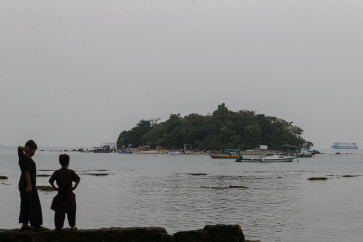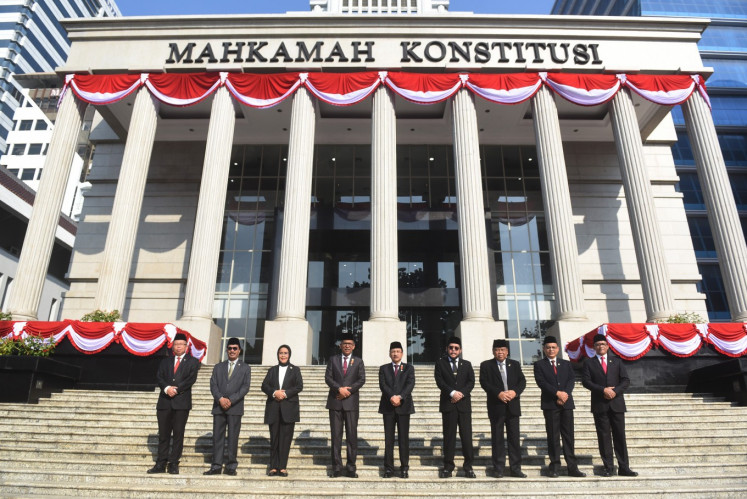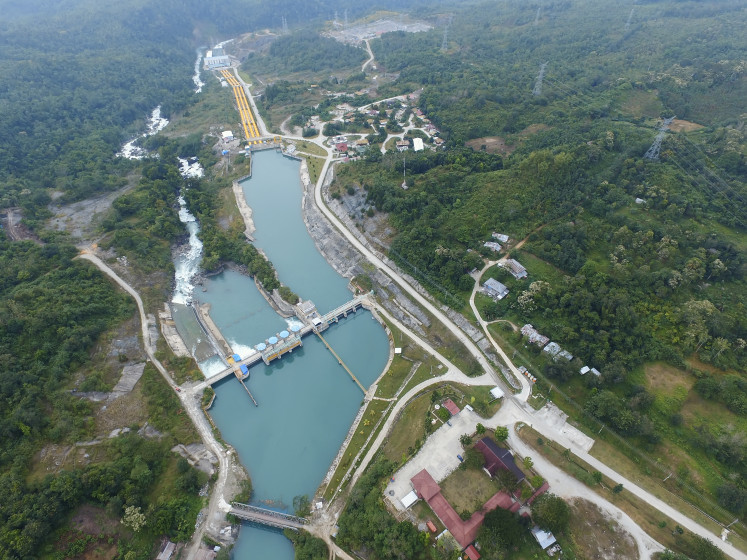Popular Reads
Top Results
Can't find what you're looking for?
View all search resultsPopular Reads
Top Results
Can't find what you're looking for?
View all search resultsMelasti, a purification ritual warmly embraced by all
Peaceful: Devotees carried jempana, the throne of the deities, during Melasti purification ritual at Batu Bolong beach in Canggu, Bali, on Tuesday
Change text size
Gift Premium Articles
to Anyone

P
span class="caption" style="width: 398px;">Peaceful: Devotees carried jempana, the throne of the deities, during Melasti purification ritual at Batu Bolong beach in Canggu, Bali, on Tuesday.As the sun lazily rises from its deep sleep amid the unceasing drizzle, thousands of Balinese, young and old, mostly in traditional white attire, devoutly flow onto the Padang Galak Beach to perform their Melasti ritual.
The annual Melasti rite, a passage in the lead-up to Nyepi, the Hindu Day of Silence that falls on March 23, aims not only at purifying the souls of the Balinese people and their universe, but more to that, it’s a huge happy gathering that no one, even children, would want to miss.
Waking up at 3 a.m. for Tuesday’s Melasti ritual on Padang Galak Beach, which is about 20 kilometers from their home in Jenah village, Ketut Subagio, 35, the father of Ary and Merta, said: “Whenever it’s time for morning rituals like today, my boys usually dash from their beds much quicker than when it’s time for school. No fretting at all.”
Schools in Bali allow students who perform Melasti and other Balinese rituals to be absent from class.
With his two boys and wife, Subagio drove his motorcycle to the beach passing through the pitch darkness of the early morning. Subagio himself has never missed the annual Melasti ritual.
“Even when not feeling well, I always make an effort to attend Melasti so that I can thank God for just being alive,” said Subagio, as he warmly greeted some friends and relatives just arrived from other villages. Only those who are deemed unsuitable, including the sick, menstruating women and anyone mourning the death of a family member within the previous 11 days, are not allowed to join the Hindu Balinese sacred ritual.
On Tuesday, the Padang Galak Beach welcomed continuous waves of Melasti celebrants on their motorcycles and in cars, as well as throngs of villagers being merrily “unloaded” from trucks and pickups. Accompanied by the sound of bleganjur gamelan instruments and the soothing fragrance of incense, the villagers brought colorful loads of offerings and their temples’ paraphernalia such as the barong and rangda effigies, various sacred figurines of deities (pratima), the traditional dance clothes and accessories to be purified by seawater.
Agung Ngurah, another resident of the Cengkilung village that lies about 10 kilometers from Padang Galak Beach, added: “We instill traditions into the lives of our youngsters by not only bringing the children to join such ritual, but also by making ogoh-ogoh effigies, for instance.”
Cengkilung village, which has some 460 residents, requires the villagers who are absent from a half-a-day of ngayah activities to pay a penalty of between Rp 500 and Rp 1,000. “But the penalty is not why we maintain our traditions. It’s because we cherish this whole togetherness,” said Made.
As all the paraphernalia and offerings were neatly arranged at the praying sites on the beach, temple priests began chanting, while villagers chose cozy spots to sit and chatted casually among fellow villagers, had some light breakfast, quenched their thirsts or simply took the time to gaze at the ocean waves. Once the priests completed their chants, villagers stopped chatting, prepared their small offerings, lit up the incense and made a brief communal prayer toward the ocean. During the prayer, a few of the Melasti participants reached a form of trance that drove them to perform particular dance movements or even stabbing themselves with a kriss (traditional dagger).
As one village concluded their rituals, another village arrived to perform their own. Around 75 villages, as well as hundreds of banjar in the capital of Denpasar take turns in performing the Melasti rituals until the last day before Nyepi.
Melasti is performed not only by villagers in Denpasar, as there are 1,475 traditional villages around the island, but the ritual is also performed all along the island’s coastline. Residents of the mountainous Bangli regency area which has no coastliness perform their rituals either at Batur Lake or at the neighboring Gianyar regency’s
Siyut Beach.
— Photos by Agung Parameswara









